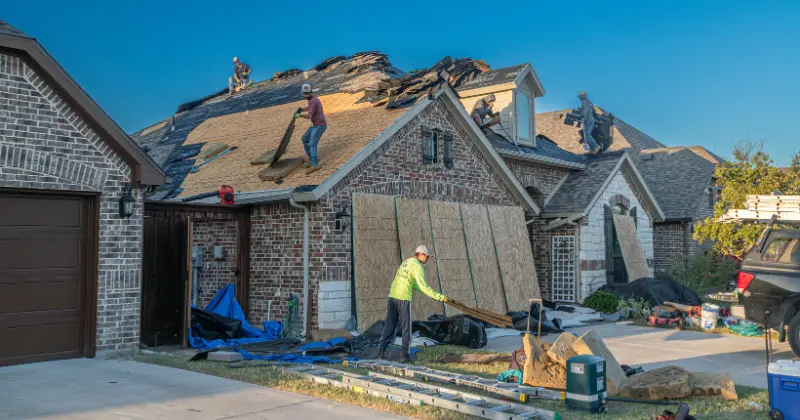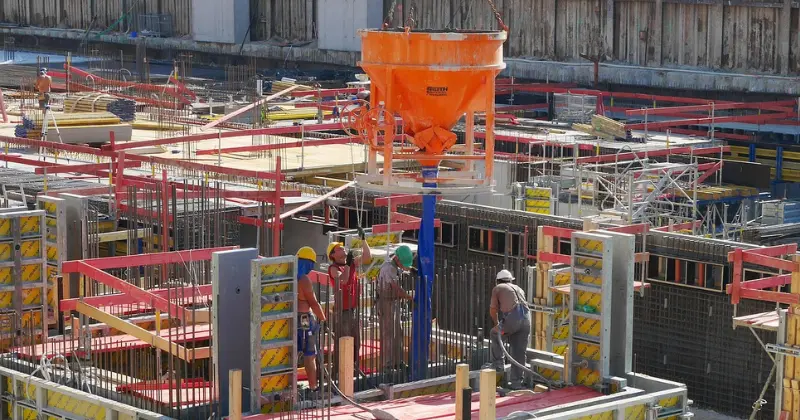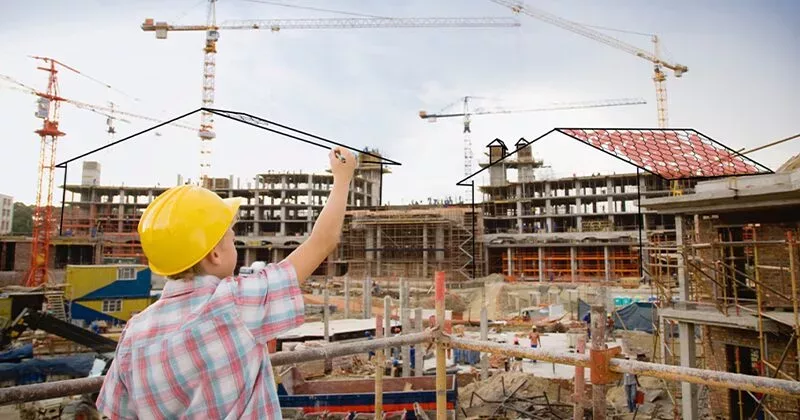11 mins read
Construction Scope of Work: Essential Tips, Best Practices, and Software Solutions

The construction scope of work (SOW) is a contract document used to fully define the required project tasks and milestones. A well-written SOW can be the difference between success and failure, since it sets the stage for the other planning and execution activities that follow, while ensuring all parties understand the goals and deliverables.
In this blog post, we review the definition and elements of an SOW in construction, while explaining the differences between related project documents. We also provide a list of tips and best practices to help construction teams create a clear and concise statement of work.
Key Takeaways
- The scope of work details the obligations of contractors, specialists and suppliers while defining important timelines and milestones.
- A construction proposal is like an SOW but is created earlier by a contractor attempting to win new business.
- The writing of an SOW is often a collaborative effort performed by stakeholders, including the client, construction architect, and owners’ representative.
- A construction scope of work checklist covers key elements such as the project deliverables, schedule, technical details, and payment terms.
- Construction software solutions support the writing and research required for an effective scope of work, while making it easier for key stakeholders to collaborate throughout the process.
What is a Construction Scope of Work?
The scope of work in construction is a revision-controlled document detailing the obligations and work activities of all contractors, specialists, and suppliers. The SOW also defines important timelines, milestones, and reporting expectations for each individual activity.
A properly written scope of work minimizes delays, schedule conflicts, and misunderstandings by describing the hierarchy and order of tasks to be performed, along with the methods and materials needed to complete each activity. The SOW should be drafted during the preconstruction phase and updated continuously to reflect any changes to the design or deliverables.
Construction scope of work vs. construction proposal
The scope of work is similar to a construction proposal in some ways, since they are both essential for project planning and resource allocation. Unlike the SOW, the proposal is created by a contractor attempting to win new business. The contractor submits proposals to clients that include tentative cost estimates and timelines, along with the additional benefits and services they expect to provide.
Proposals can become useful inputs during the SOW writing process, since they help to baseline the specific tasks, roles, and responsibilities that must be considered for each activity. While the proposal is a preliminary offer from contractor to client, the scope of work is a legally binding contract document created after the project is approved.
Who writes a scope of work in construction?
The client, with preliminary input from contractors, is ultimately responsible for generating the scopes of work for construction projects they initiate, but they will often delegate this task to architects, designers, owners’ representatives, or some combination thereof once they have established the high-level vision and selected the general contractor.
The breadth of information included in the SOW makes it difficult for any single individual to complete this task on their own, so this work is often performed collectively to ensure the insight and experience of each party is taken into consideration. Construction software is extremely useful for collaborating on new SOW documents from various locations while leveraging powerful planning, estimation, and forecasting capabilities.
Why is a Scope of Work Important in Construction?
The scope of work for a building, infrastructure project, renovation, or any other major construction endeavor is essential since it creates a roadmap for all parties involved to follow. This reduces the confusion and uncertainty that can derail progress or lead to lingering misunderstandings. The SOW also supports accurate quantity takeoff, estimation, and bidding processes to ensure the project budget aligns with reality.
The scope of work guides project managers and preserves schedule integrity by defining what is or is not in scope, making it clear when change orders must be completed to add new tasks and activities. As a legally binding contract document, the SOW establishes boundaries that can prevent construction disputes from escalating.
Construction Scope of Work Checklist
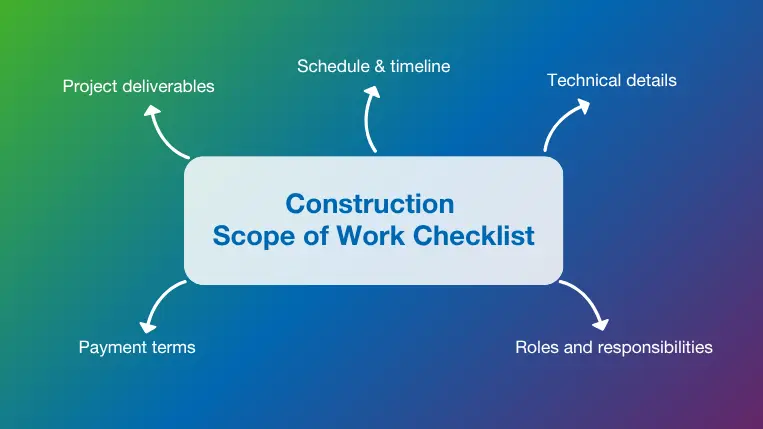
The contents and details captured in the scope of work vary for each project, but several key sections should be included to make sure the project scope is fully defined. A standard checklist covering the following elements helps to guide the writing process:
- Project deliverables: This section should list all expected project goals and objectives, with sufficient details to describe what task completion entails. Additional information on equipment, project milestones, and unique installation methods allows contractors to plan their activities well in advance.
- Schedule & timeline: The timeline included in a construction scope of work does not carry the same level of detail found in the working project schedule, but it should map out the expected duration for each deliverable, and the sequence and interdependencies related to each task.
- Technical details: Information on specific materials, sustainability objectives, performance specifications, and site conditions should be included within a section dedicated to the technical aspects of the project. This section goes beyond the “what” to establish the “how” for complex task execution.
- Roles and responsibilities: The individual task assignments related to construction should be established within the SOW, along with the leadership responsibilities, reporting hierarchy, and communication protocols. A comprehensive review of roles and assignments creates a baseline for effective collaboration throughout the project.
- Payment terms: Financial details are not always included in the SOW, but adding this information makes it easier for stakeholders to review pre-defined invoicing and payment triggers based on task completion, along with expense reimbursement protocols and other important payment terms.
How to Write a Scope of Work for Construction: Tips & Best Practices
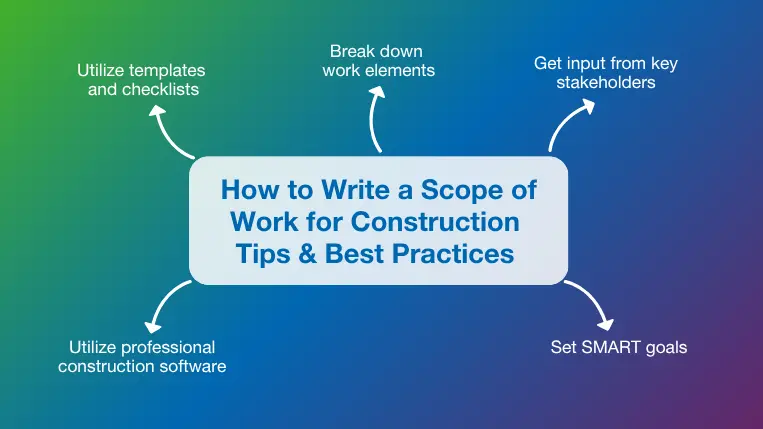
A well-written scope of work is one of the keys to a successful outcome, so utilizing some recognized best practices and software tools helps teams create SOWs that clearly establish the roles, responsibilities, and deliverables of the project.
Utilize templates and checklists
The SOW in construction projects vary significantly, but standardized checklists and templates help to ensure all important elements are included. Templates establish clear project boundaries upfront and make the SOW easier to follow by using a consistent document format. They also save time and effort by eliminating the need to create the document from scratch. A construction scope of work checklist is a convenient way to categorize, list, and summarize task descriptions and assignments.
Break down work elements
Modern construction projects can be highly complex, so breaking the SOW into smaller elements makes it easier for readers to follow. One common approach is to begin the document with high-level information, then create new sections for each successive level of activity. A work breakdown structure (WBS) helps to separate activities logically by phase, system, and subsystem, then break each element into concise work packages and milestones.
Get input from key stakeholders
The accuracy and quality of the construction scope of work impacts the entire project, so it is important to engage key stakeholders throughout the writing process. Feedback should be gathered through both informal discussions and formal cross-functional reviews. A stakeholder map can be helpful to identify reviewers with both high influence and high interest, such as clients, architects, designers, and general contractors.
Set SMART goals
The SMART acronym allows writers to create SOW goals and objectives that consistently add value to the project and remove ambiguity. SMART goals are:
- Specific enough to remove any doubts about the requirements.
- Measurable so that progress can be quantified and completion verified.
- Achievable by the contractor or subcontractor performing the work.
- Relevant to the high-level goals and objectives of the project.
- Time-oriented to ensure due dates and milestones are meaningful.
Utilize professional construction software
Construction software makes it easier to create, edit, and collaborate on scopes of work for construction, with access to real-time project data, cost information, and resource analysis capabilities, simplifying SOW creation and supporting the generation of accurate contract documents. RIB Candy provides an interactive link between the bill of quantities (BoQ), estimate, and program to provide an intuitive window into deliverables and timelines.
Conclusion
The construction scope of work is among the most important early project phase deliverables, since it creates a common roadmap for all contractors, subcontractors, and suppliers to follow as they guide the project to a successful conclusion. The complexity of the SOW often calls for a team effort during the writing process, with experts and specialists providing their unique perspectives. Software tools bring these contributors together seamlessly to create a more complete and valuable document.
RIB Candy software supports SOW creation with resource-based estimating, alternative tendering capabilities, customized reports, and a critical path networking system designed specifically for the construction industry. Advanced forecasting capabilities provide invaluable information for feasibility and progress monitoring.
RIB Candy takes the quality of SOWs, quantity takeoffs, estimation, planning, and cash flow management to the next plateau. Get a free demo today and experience what RIB can do for your organization!
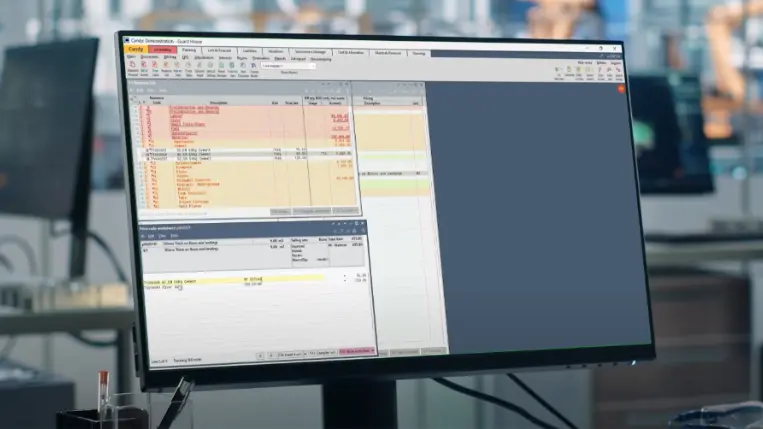
Book a Free Trial for RIB Candy
Most Recent
11 mins read
10 mins read
10 mins read
29 mins read
Blog Categories

Ebook




